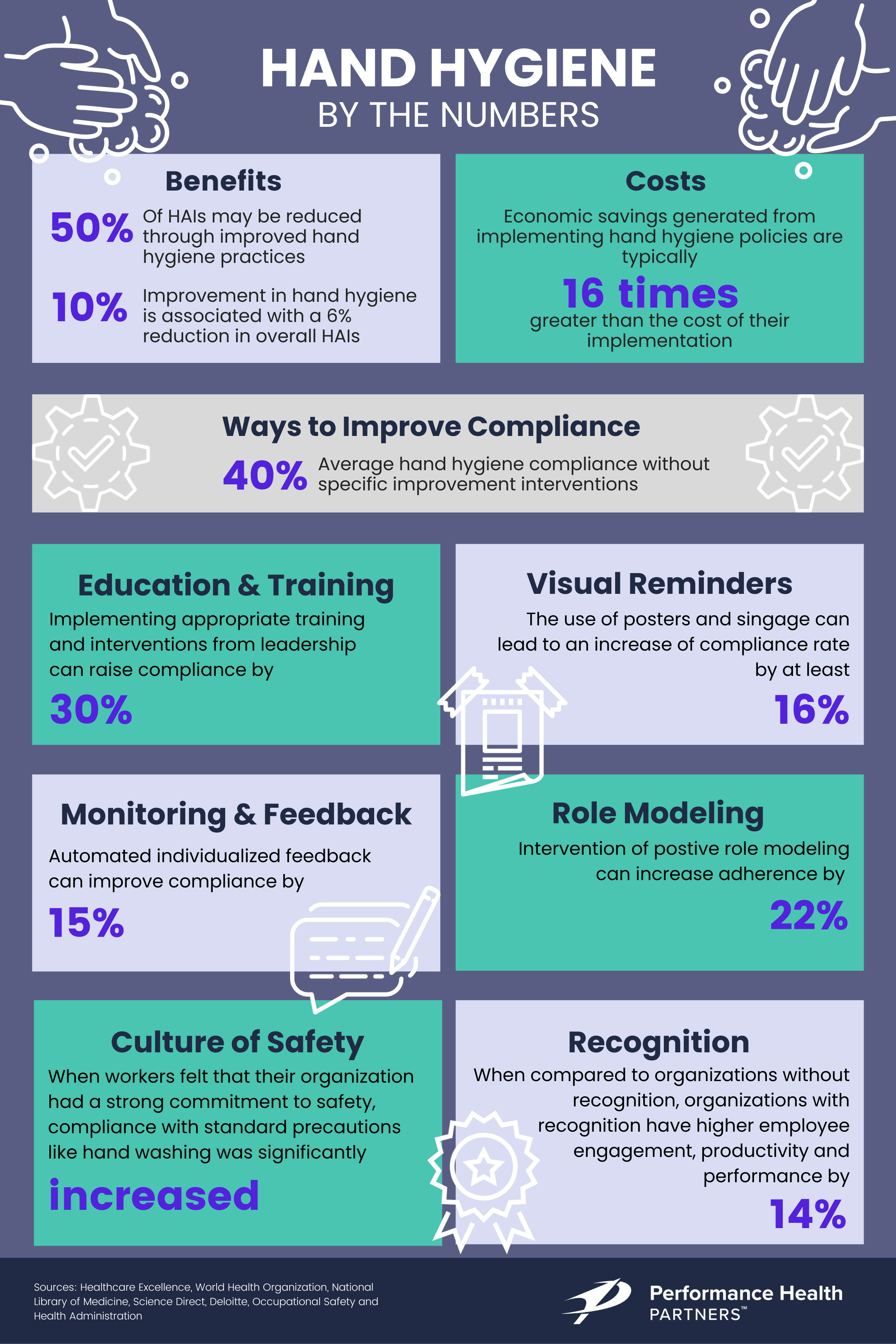To substantially boost hand hygiene compliance—a simple but crucial measure to thwart the transmission of infections—employ these seven strategic approaches in your healthcare organization. Adopting these tactics not only reinforces a culture of safety and care but also serves as a frontline defense against health care-associated infections, protecting both patients and staff.
How to Improve Hand Hygiene Compliance
Read on for a list of tried and true hand hygiene recommendations to effectively improve hand hygiene compliance at healthcare organizations.
Implement Comprehensive Education & Training Programs
Effective hand hygiene is a cornerstone of infection control in healthcare and necessitates a comprehensive approach to education and training within the care environment. It is imperative that all individuals, including medical staff, patients, and visitors, are well-informed about the critical importance of hand hygiene and are proficient in the correct handwashing techniques.
Ongoing education is vital to establish uniformity in practice, ensuring every participant understands not only the “how” but also the “when” for hand hygiene—before and after direct patient contact, post-contact with potentially contaminated surfaces, and subsequent to the removal of gloves. Continual updates and training reinforce this knowledge, aligning everyone with the most current guidelines and handwashing best practices.
Evidence underscores the value of hand hygiene education initiatives; targeted training and leadership-driven interventions have demonstrably improved hand hygiene compliance among nursing staff by 30%.
Remarkably, this heightened adherence was sustained for at least six months following the initial implementation, underscoring the long-term benefits of rigorous training programs.

Ensure Easy Access to Hand Hygiene Products
For the facilitation of consistent hand hygiene practices, it is critical to ensure the ubiquitous presence of hand sanitizers and soap within the facility. Strategic placement of dispensers at key locations—patient rooms, hallways, nursing stations, and communal spaces—enhances visibility and convenience, thereby promoting their regular utilization.
It’s essential that these dispensers are not only positioned in plain sight but are also consistently restocked and meticulously maintained to support seamless integration into daily hygiene protocols.
Use Visual Reminders
Visual cues can play a significant role in reinforcing the importance of hand hygiene. When designing these materials, use clear, concise language and engaging graphics. The use of images can help convey the message to people who may have difficulty reading or understanding complex information. The use of posters and signage can lead to an increase in hand hygiene compliance rate by at least 16.1%.
By placing these visual tools in key locations around the healthcare facility, they serve as constant, persuasive reinforcements of hand hygiene's importance, thereby maintaining high awareness and hand hygiene adherence among all individuals within the facility.
Here are ten free, downloadable hand hygiene posters that can be printed and posted in your facility.
Establish Robust Monitoring & Provide Constructive Feedback
Implement a system for monitoring hand hygiene compliance, such as direct observation or electronic monitoring systems. Conduct systematic evaluations of hand hygiene protocols among healthcare professionals and support staff. Utilize this data to deliver constructive, non-punitive feedback that identifies areas for improvement and acknowledges commendable performance. This strategy fosters an environment of accountability and encourages the pursuit of excellence in hand hygiene practices.
Integrate these assessments into regular hospital rounds, reinforcing the importance of hand hygiene directly within the clinical context. This on-the-spot guidance not only serves as a reminder but also aids in cementing the practice as a habitual standard of care.
Utilizing tools like rounding software can streamline this process, offering real-time insights into hand hygiene compliance and tracking advancements in these essential practices within your institution.
Promote a Culture of Safety
Promoting a culture of safety within your healthcare facility is crucial. Encourage open communication about hand hygiene practices. Staff must be empowered to voice hand hygiene concerns and report safety issues and observations, assured that their input is valued and that retaliation is non-existent.
This level of candid communication is vital for swiftly pinpointing and addressing challenges, leading to effective problem-solving. Moreover, it nurtures a collaborative ethos and collective accountability, which are instrumental in upholding a safe, health-centric environment for both patients and healthcare professionals.
Demonstrate Commitment Through Role Modeling
Leadership by example is a fundamental driver in enforcing hand hygiene standards within healthcare facilities. It is imperative for those in positions of leadership — including managers, physicians, and senior staff — to exhibit impeccable hand hygiene consistently. Such demonstrative leadership reinforces the importance of hand hygiene and has a domino effect, inspiring the entire team to emulate these best practices.
Research underscores the potency of positive role modeling in enhancing hand hygiene compliance.
One study revealed a notable increase of approximately 22% in adherence when leadership actively engaged in role modeling, with a sustained compliance rate of 70% for at least 15 months following the initiative.
This evidence affirms that when leaders prioritize hand hygiene, it becomes ingrained in the facility's culture, cementing it as a fundamental healthcare protocol.
Develop Incentive Program & Offer Recognition Rewards
Instituting a system of incentives and acknowledgment is a strategic approach to sustain and elevate hand hygiene compliance. It is recommended to formally recognize and reward healthcare personnel who consistently meet or exceed hand hygiene standards. Celebrating these individuals publicly not only serves as a testament to their dedication but also acts as a compelling motivator for their peers.
The impact of such recognition programs is profound; they engender a culture of positivity and are a testament to the organization's commitment to valuing diligent hand hygiene practices. Deloitte's research indicates that organizations with a recognition-rich culture have 14% higher employee engagement, productivity, and performance compared to those without.
By embedding these recognition strategies within your hand hygiene initiatives, you not only mitigate healthcare acquired infection risks but also cultivate a pervasive culture of health and safety. Prioritizing hand hygiene transcends immediate benefits, contributing to a safer and health-conscious community at large.
Ready to get started?
Learn how Performance Health Partners’ rounding software can help your organization improve hand hygiene compliance. Click here to get started.


